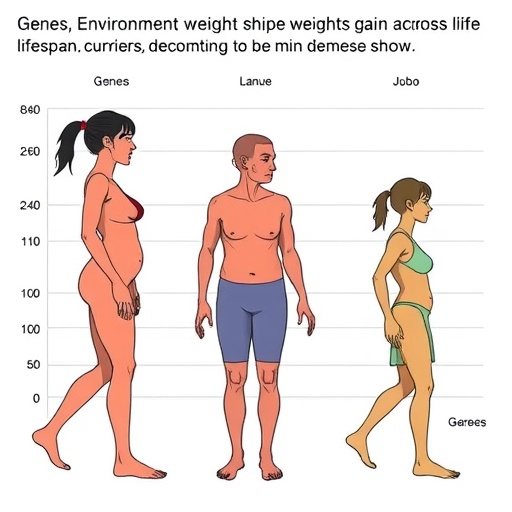Sarcopenia, characterized by the progressive loss of muscle mass and strength, poses a significant challenge to the aging population globally. As individuals age, the risk factors associated with sarcopenia become increasingly pronounced, leading to a decline in functional mobility, increased frailty, and a higher incidence of falls. In light of these implications, the need for effective interventions has never been more critical. A recent systematic review and Bayesian network meta-analysis, spearheaded by Wei et al., endeavors to unravel the complexities of exercise interventions for this debilitating condition.
The study meticulously reviews various exercise intervention subtypes, assessing their effectiveness in combating the grip of sarcopenia. By aggregating data from multiple trials, the authors aimed to determine which specific types of exercise can yield the most significant benefits for elderly populations grappling with muscle deterioration. Their approach not only enhances our understanding of exercise effectiveness but also sets a foundation for future research aimed at optimizing intervention strategies for sarcopenia.
Among the numerous exercises analyzed, resistance training emerged as a chief contender. This form of exercise has consistently demonstrated its prowess in enhancing muscle strength and mass. Through a series of repetitive contractions against resistance, individuals can stimulate muscle protein synthesis, ultimately leading to hypertrophy. The findings suggest that tailored resistance training programs could potentially alleviate the consequences of sarcopenia, drastically improving the quality of life for older adults.
Complementing resistance training, aerobic exercises also featured prominently in the analysis. While primarily known for its cardiovascular benefits, aerobic exercise has been shown to have ancillary effects on muscle function. Activities such as brisk walking, cycling, or swimming, when incorporated into a regular exercise regimen, may enhance overall endurance, thereby facilitating the performance of daily activities more adeptly. The authors of the study highlight how a synergistic approach that incorporates both resistance and aerobic activities might yield better outcomes in the battle against sarcopenia.
Furthermore, the research emphasizes the importance of exercise duration and frequency. Evidence points to the benefits of engaging in exercise multiple times a week with sustained effort over extended periods. Building an effective routine not only fosters muscle growth but also sets a precedent for habit formation, which is crucial for long-term adherence. The researchers advocate for individualized exercise regimens tailored to the unique needs and preferences of the older population, ensuring that interventions are both effective and sustainable.
With sarcopenia often correlating with comorbidities such as obesity and cardiovascular diseases, the study underscores the need to address multifaceted health conditions in exercise interventions. By adopting an integrative approach that considers the individual’s comprehensive health profile, exercise can be used as a powerful tool not only against muscle loss but also as a vital component in enhancing overall wellness. This perspective urges healthcare professionals to collaborate with patients, facilitating the creation of comprehensive exercise plans that incorporate medical history and physical capability assessments.
An often-overlooked aspect of exercise intervention is the psychological dimension. Engaging older adults in physical activity can significantly enhance their mental health, boosting confidence and reducing symptoms of anxiety and depression, which are often linked to the aging process. The findings suggest that mental and emotional well-being should be taken into account when crafting exercise programs. Community-based initiatives and support groups may further empower individuals, fostering motivation and accountability in pursuing their physical health goals.
Moreover, the implications of this research extend beyond individual health, resonating with public health strategies aimed at mitigating the societal burden of aging populations. As countries grapple with increasing healthcare costs associated with age-related conditions, promoting effective exercise interventions can lead to a more active and independent elderly demographic, thereby reducing overall healthcare expenditures.
In summary, the systematic review led by Wei et al. offers valuable insights into optimal exercise interventions for sarcopenia. By synthesizing data from various studies, the authors provide a compelling argument for the integration of resistance and aerobic exercises tailored to the individual needs of older adults. This findings could guide future research and public health initiatives aimed at combating sarcopenia’s pervasive effects on aging populations.
As the landscape of healthcare continues to evolve, understanding the intricate interplay between exercise, muscle health, and overall well-being will be paramount. The research demonstrates that equipping aging individuals with the knowledge and resources to engage in effective exercise regimens can yield transformative health outcomes. As the quest for solutions to sarcopenia unfolds, this study shines a light on the promising role of structured physical activity in enhancing the longevity and quality of life for older adults.
In conclusion, Wei et al.’s research not only contributes significantly to the existing body of knowledge on sarcopenia but also sets the stage for future explorations into effective health interventions. The next steps will undoubtedly involve more extensive longitudinal studies and continued dialogue between researchers, clinicians, and the elder community to refine exercise recommendations and ensure adherence. Ultimately, fostering an active lifestyle for the elderly may well be our most potent weapon against the specter of sarcopenia.
Subject of Research: Sarcopenia and exercise interventions for elderly populations
Article Title: Explore the optimal exercise intervention subtype for sarcopenia: a systematic review and Bayesian network meta-analysis
Article References:
Wei, M., He, S., Zhang, X. et al. Explore the optimal exercise intervention subtype for sarcopenia: a systematic review and Bayesian network meta-analysis. BMC Geriatr 25, 862 (2025). https://doi.org/10.1186/s12877-025-06529-w
Image Credits: AI Generated
DOI: https://doi.org/10.1186/s12877-025-06529-w
Keywords: Sarcopenia, exercise intervention, resistance training, aerobic exercise, elderly health, systematic review, Bayesian network meta-analysis.
Tags: aging population health strategieseffective interventions for sarcopeniaexercise impact on muscle strengthexercise types for elderly fitnessfall prevention through exercisefunctional mobility and sarcopeniamuscle mass loss in agingmuscle protein synthesis and agingoptimizing sarcopenia intervention strategiesresistance training for elderlysarcopenia prevention exercisessystematic review on sarcopenia





